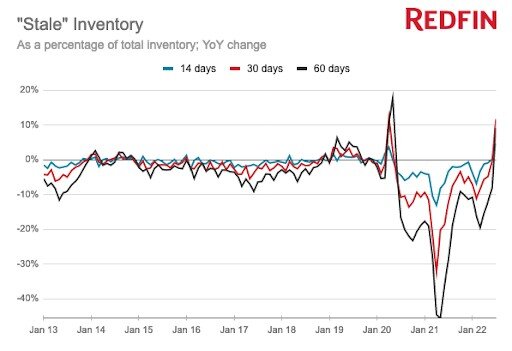Residential Real Estate News

Growing Share of U.S. Listings Going Stale As Multiple Housing Markets Cool
Residential News » Phoenix Edition | By Michael Gerrity | August 10, 2022 8:51 AM ET
According to national property broker Redfin, the share of U.S. homes that were listed for 30 days or longer without going under contract increased 12.5% in July 2022 from a year earlier. In other words, 61.2% of for-sale homes were on the market for at least 30 days, up from 54.4% a year earlier.
That's the first year-over-year increase in "stale" housing supply since the beginning of the pandemic and close to the biggest uptick in Redfin's records, which go back to 2012.
The only time it increased more (13.9% YoY) was in April 2020, when the housing market nearly ground to a halt. For this report, "stale" refers to homes that were on the market for at least 30 days without going under contract, according to Redfin data.
Homes staying on the market longer is a reflection of the housing market slowing in response to 5%-plus mortgage rates and a shaky economy. Rates shot up quickly in the first half of 2022, reaching 5.8% in June before dropping slightly to an average of 5.4% in July. It has taken several months of buyers backing off and sellers rushing to list their homes before the market cools further to culminate in inventory piling up.
The uptick in stale inventory is one reason why the supply shortage is easing: The total number of U.S. homes for sale was up 4% year over year in July, the biggest increase since mid-2019. That's largely due to homes staying on the market longer; the number of new listings was down 6%.
"People want to know whether we've officially shifted from a seller's market to a buyer's market. While there's not a clear line separating those two ideas, homes sitting on the market longer is a point in buyers' favor," said Redfin Deputy Chief Economist Taylor Marr. "Buyers can take their time making careful decisions about homes without worrying so much about bidding wars, offering over the asking price and waiving contingencies. It's a different story for sellers, who have spent the last two years hearing about their neighbors' homes getting multiple offers the day they go on sale. Now they need to price lower and get back to the basics of selling a home, like staging and sprucing up painting, to get buyers' attention."
A look at homes staying on the market for over two weeks and over two months also illustrates the slowing market. The share of for-sale homes listed for two weeks or longer was up 7.6% year over year in July (it rose from 74.6% to 80.3%), the second increase since the beginning of the pandemic (the first was a 0.1% uptick the previous month) and the biggest on record. And the share of for-sale homes on the market for 60 days or longer was up 6.8% (31.4% to 33.5%), the first increase since the beginning of the pandemic.
Although homes are staying listed longer than they were at the height of the pandemic home buying frenzy, time on market is still historically low. The typical home stayed on the market longer in 2018 and 2019 than now, for instance.
The big year-over-year uptick in stale inventory is likely to stabilize soon, as it's partly a reflection of last year's red-hot housing market, when homes were selling very quickly. The typical home went under contract in 15 days in July 2021-close to the fastest on record-prices hit an all-time high and the total number of homes for sale dropped to a record low, driven by sub-3% mortgage rates.
The share of housing supply that was stale was stable before the pandemic, with any fluctuations largely due to typical seasonal patterns.
Stale inventory has increased most in Oakland, CA
The share of for-sale Oakland, CA homes sitting on the market for at least 30 days was up 60.7% year over year in July, the biggest increase of the 50 most populous U.S. metros. It's followed by Phoenix, where the share of stale inventory rose 54.5% year over year. Next come Austin (50.9%) and a pair of Southern California metros: Anaheim (49.7%) and Riverside (46.7%). Fort Worth (43.4%), Dallas (42.9%), Washington, D.C. (42.5%), Sacramento 41.7%) and Seattle (41.3%) round out the top 10.
More than half of those places-Oakland, Phoenix, Austin, Anaheim, Riverside, Sacramento and Seattle-are among the 20 housing markets that cooled fastest in the first half of 2022.
"The market did a 180-degree turn from early spring to late spring, with buyers backing out because of high mortgage rates. A lot of sellers are telling me they feel that they've missed out on the hot market," said Christopher Johns, a Redfin agent in Houston, where the share of stale inventory rose 10.2% year over year in July. "I'm reminding prospective sellers that we're not in a housing-market crash; it's a correction. If sellers list their home for slightly less than they would have five months ago, they're still likely to get a solid offer. And my advice to buyers is to remember that 5% rates aren't the end of the world; they can always refinance in the future if rates go down."
The share of stale inventory declined in just one metro: Fort Lauderdale, FL, where it was down about 1% year over year in July 2022.

Sign Up Free | The WPJ Weekly Newsletter
Relevant real estate news.
Actionable market intelligence.
Right to your inbox every week.
Real Estate Listings Showcase
Related News Stories
Residential Real Estate Headlines
- Las Vegas Area Home Prices Uptick 4.3 Percent Annually in March
- Single-Family Rent Growth in U.S. Trends Upward in 2025
- U.S. Mortgage Rates Tick Down Post Trump Tariffs Commencement
- President Trump's 'Liberation Day' Tariffs Potential Impact on the U.S. Housing and Mortgage Markets
- Baby Boomers Biggest Cohort of U.S. Home Buyers in 2025 as Millennials Decline
- U.S. Monthly Housing Payments Hit Record High in 2025
- U.S. Pending Home Sales Uptick in February
- Global Prime Residential Rent Slowdown Continued in Late 2024
- Ireland Home Price Inflation Hits 8 Year High in Early 2025
- Existing Home Sales in America Uptick in February
- Great Miami Area Residential Sales Decline 15 Percent Annually in February
- Mortgage Rates Uptick in Mid-March, Ending 9-Week Decline in U.S.
- World Property Ventures Builds the Future of Real Estate with New Funding Round
- U.S. Builder Sentiment Declines Amid Economic Uncertainty and Rising Costs
- Black Homeownership Rates in U.S. Enjoy Largest Annual Increase of All Racial Groups
- Wealthy Renters Are Taking Over More of the U.S. Rental Market
- If U.S. Congress Does Not Extend NFIP Soon, Thousands of Daily Home Closings Impacted
- U.S. Mortgage Applications Spike 11 Percent in Early March
- Greater Palm Beach Area Residential Sales Rise in Early 2025
- New Apartments in U.S. Are Leasing at Slowest Pace on Record
- U.S. Mortgage Rates Drop to 4 Month Low in March
- Overall U.S. Mortgage Delinquency Rates Dip in December
- New Tariffs on Canada, Mexico to Impact U.S. Homebuilder Input Costs
- Monaco's Property Market: A Tale of Two Cities
- U.S. Home Purchase Cancellations Surge, 1 in 7 Sales Getting Canceled
- U.S. Pending Home Sales Hit Historic Low in Early 2025
- Greater Miami Area Residential Sales Dip in January
- Governor DeSantis Supports Ending Property Taxes in Florida
- WPV Aims to Become the Berkshire Hathaway of Real Estate Tech
- U.S. Home Sales Slump Continues in January
- Average Americans Spend 38 Percent of Monthly Income on Mortgage Payments
- Switzerland's Safe-Haven Appeal Grows with World's Wealthy Homebuyers
- U.S. Builder Confidence Rapidly Declines in February
- Las Vegas Home Sales Rise 6.7 Percent Annually in January, Condo Sales Dip
- Homebuyer Demand in America Drops to 5-Year Low in Early 2025
- Ownership More Affordable Than Renting in Most U.S. Markets
- The World's First Global Listings Service Launches, Called a GLS
- Home Prices Continue to Rise in 89 Percent of U.S. Metros in Late 2024
- Global Luxury Residential Prices Showed Gradual Improvement in Late 2024
- U.S. Construction Hiring Rate Drops to Lowest Levels in 5 Years





